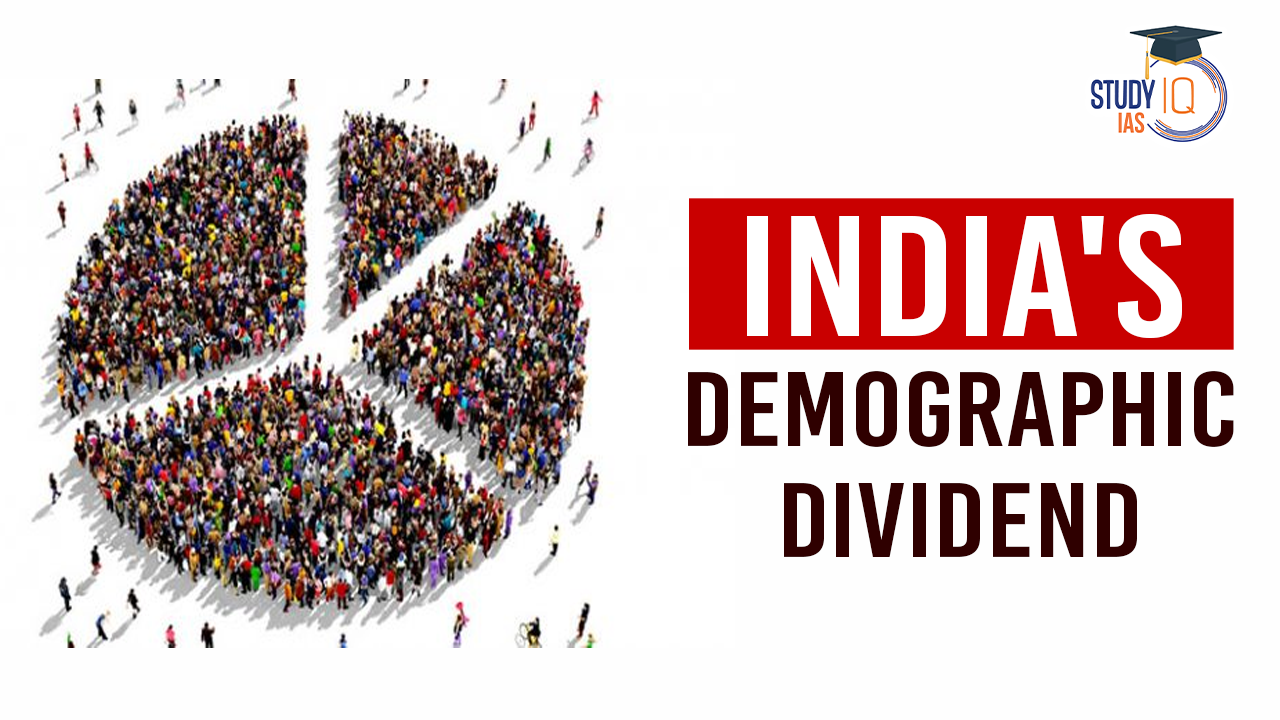Table of Contents
Context
- India’s demographic dividend offers immense potential for economic growth.
- However, realising this potential requires a strategic approach to address various challenges.
What is Meant by Demographic Dividend?
- Demographic dividend refers to the economic growth that occurs when a country’s population has a large proportion of working-age people (15 to 64 yrs) and a small proportion of dependent children and elderly people (14 and younger, and 65 and older).
- In India around 68% of the population falls into the working age, and 26% falls within the 10-24 age group.
- Also it is projected that India will have04b working age persons and India’s dependency ratio would be the lowest at 31.2% by 2030.
Importance of India’s Demographic Dividend
- Increased Labor Supply: A large young population provides a growing workforce.
- Enhanced Capital Formation: Lower dependency ratios lead to higher savings rates, fueling investment and economic growth.
- Boosted Economic Growth: Increased domestic demand and GDP per capita drive economic expansion.
- Innovation and Entrepreneurship: A young population is often more innovative and entrepreneurial.
- Improved Female Human Capital: Decreased fertility rates can lead to greater female participation in the workforce, enhancing human capital.
Challenges in Harnessing India’s Demographic Dividend
- Lack of Job Creation: India’s economy is not generating enough jobs to meet the demands of a rapidly growing population.
- Example: The Labour Force Participation Rate (LFPR) was only 55.2% in 2022 according to the International Labour Organization (ILO) report.
- Lack of Quality Education: The education system is not preparing young people for the job market.
- Example: Approximately 85% of Chinese children possess basic skills required for the international economy, compared to only 15% of Indian children.
- Skills Shortage: Only 4.4% of the workforce in the age cohort of 15-29 years is formally skilled, according to the Economic Survey 2023-24.
- Challenges for MSMEs: Micro, Small and Medium Enterprises (MSMEs) face barriers in scaling up due to compliance burdens from outdated labour laws.
- Technological Advancements: While AI/ML offers opportunities, it also poses a challenge in terms of job displacement.
- Example: AI/ML is estimated to grow by nearly nine times to become a $826.73 billion worldwide market by 2030, with a current gap between demand and supply of 51% in India)
- Employment in Unorganised and Non-Agricultural Sectors: About 19% of the workforce is engaged in the unorganised and non-agricultural sectors, which are highly fragmented and suffer from low productivity.
- Capital-Led Economic Growth: The Economic Survey for 2023-24 states that technological advancements have led to a declining capital-to-output ratio and an increasing capital-to-labour ratio, making capital-led economic growth not ideal for India.
Reforms Required
- Press Ahead with Ongoing Reforms Agenda: There is a need to press ahead with the ongoing reforms agenda to maintain, if not accelerate, India’s growth trajectory.
- Enhance Ease of Doing Business: The Centre has done much to enhance ease of doing business, but more needs to be done, especially in the context of production, which concerns the States.
- Implement New Labour Codes: The impasse over implementing the new labour codes approved by Parliament needs to be resolved, and one or two States with an evolved manufacturing ecosystem should take the lead.
- Boost to Manufacturing Sector: The Centre’s efforts to give a boost to the manufacturing sector are necessary, as it is untenable for 45% of the workforce to be employed in the agricultural sector, which accounts for only 18% of GDP.
- Focus on High-Growth Potential Sectors: It is important to address the aspirations of those engaged in unorganised and non-agricultural sectors by focusing on high-growth potential sectors such as toys, apparel, tourism, and logistics, which are also labour-intensive.
- Meaningful Public-Private Partnerships: Skilling requires meaningful public-private partnerships wherein industry plays an integral role in devising the curriculum and imparting ‘on the job training’.
- Review and Update the New Education Policy (NEP) 2020: The NEP 2020 needs to be reviewed periodically and updated to keep pace with the changing job market.


 SAMARTH Udyog Bharat 4.0: Transforming I...
SAMARTH Udyog Bharat 4.0: Transforming I...
 BHIM 3.0 Launched by NPCI: Key Features,...
BHIM 3.0 Launched by NPCI: Key Features,...
 150th Summit of Inter-Parliamentary Unio...
150th Summit of Inter-Parliamentary Unio...





















